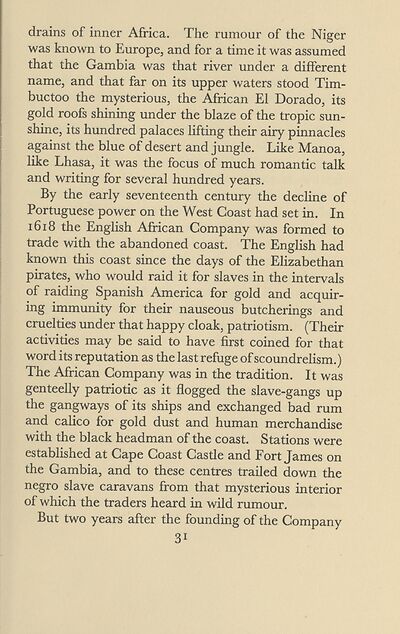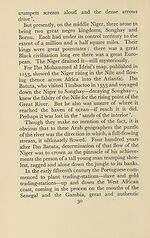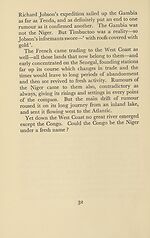Niger
(37)
Download files
Complete book:
Individual page:
Thumbnail gallery: Grid view | List view

drains of inner Africa. The rumour of the Niger
was known to Europe, and for a time it was assumed
that the Gambia was that river under a different
name, and that far on its upper waters stood Tim-
buctoo the mysterious, the African El Dorado, its
gold roofs shining under the blaze of the tropic sun¬
shine, its hundred palaces lifting their airy pinnacles
against the blue of desert and jungle. Like Manoa,
like Lhasa, it was the focus of much romantic talk
and writing for several hundred years.
By the early seventeenth century the decline of
Portuguese power on the West Coast had set in. In
1618 the English African Company was formed to
trade with the abandoned coast. The English had
known this coast since the days of the Elizabethan
pirates, who would raid it for slaves in the intervals
of raiding Spanish America for gold and acquir¬
ing immunity for their nauseous butcherings and
cruelties under that happy cloak, patriotism. (Their
activities may be said to have first coined for that
word its reputation as the last refuge of scoundrelism.)
The African Company was in the tradition. It was
genteelly patriotic as it flogged the slave-gangs up
the gangways of its ships and exchanged bad rum
and calico for gold dust and human merchandise
with the black headman of the coast. Stations were
established at Cape Coast Castle and Fort James on
the Gambia, and to these centres trailed down the
negro slave caravans from that mysterious interior
of which the traders heard in wild rumour.
But two years after the founding of the Company
31
was known to Europe, and for a time it was assumed
that the Gambia was that river under a different
name, and that far on its upper waters stood Tim-
buctoo the mysterious, the African El Dorado, its
gold roofs shining under the blaze of the tropic sun¬
shine, its hundred palaces lifting their airy pinnacles
against the blue of desert and jungle. Like Manoa,
like Lhasa, it was the focus of much romantic talk
and writing for several hundred years.
By the early seventeenth century the decline of
Portuguese power on the West Coast had set in. In
1618 the English African Company was formed to
trade with the abandoned coast. The English had
known this coast since the days of the Elizabethan
pirates, who would raid it for slaves in the intervals
of raiding Spanish America for gold and acquir¬
ing immunity for their nauseous butcherings and
cruelties under that happy cloak, patriotism. (Their
activities may be said to have first coined for that
word its reputation as the last refuge of scoundrelism.)
The African Company was in the tradition. It was
genteelly patriotic as it flogged the slave-gangs up
the gangways of its ships and exchanged bad rum
and calico for gold dust and human merchandise
with the black headman of the coast. Stations were
established at Cape Coast Castle and Fort James on
the Gambia, and to these centres trailed down the
negro slave caravans from that mysterious interior
of which the traders heard in wild rumour.
But two years after the founding of the Company
31
Set display mode to:
![]() Universal Viewer |
Universal Viewer | ![]() Mirador |
Large image | Transcription
Mirador |
Large image | Transcription
Images and transcriptions on this page, including medium image downloads, may be used under the Creative Commons Attribution 4.0 International Licence unless otherwise stated. ![]()
| The books of Lewis Grassic Gibbon > Niger > (37) |
|---|
| Permanent URL | https://digital.nls.uk/205174745 |
|---|
| Description | Sixteen books written by Lewis Grassic Gibbon (1901-1935), regarded as the most important Scottish prose writer of the early 20th century. All were published in the last seven years of his life, mostly under his real name, James Leslie Mitchell. They include two works of science fiction, non-fiction works on exploration, short stories set in Egypt, a novel about Spartacus, and the classic 'Scots Quair' trilogy which includes 'Sunset Song'. Mitchell's first book 'Hanno, or the future of exploration' (1928) is rare and has never been republished. |
|---|---|
| Additional NLS resources: |
|

